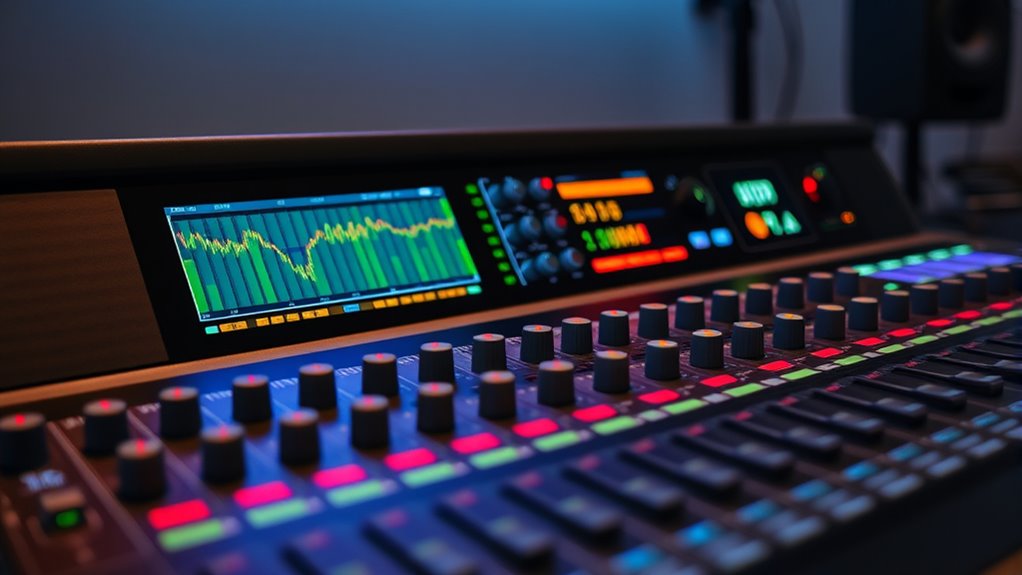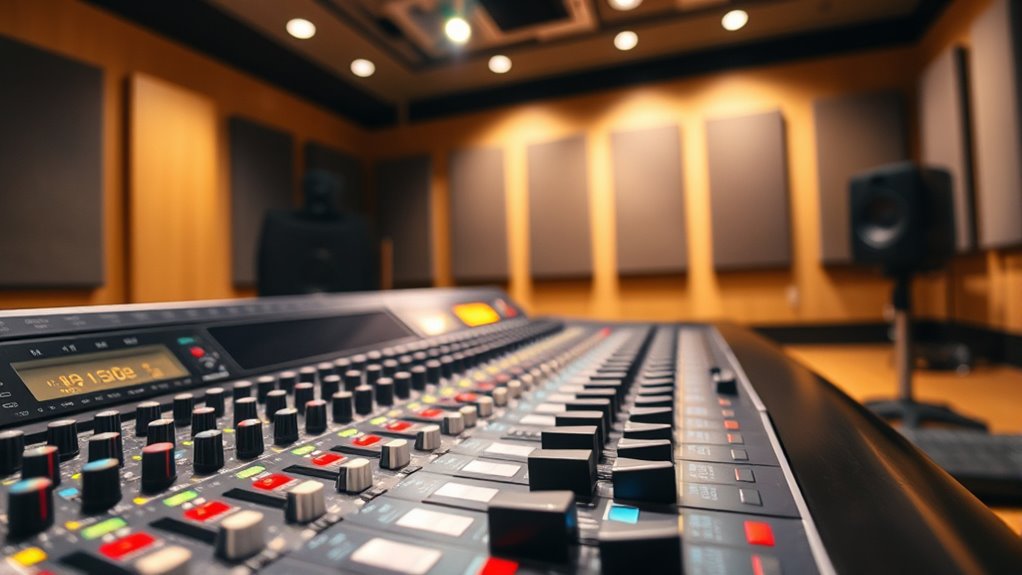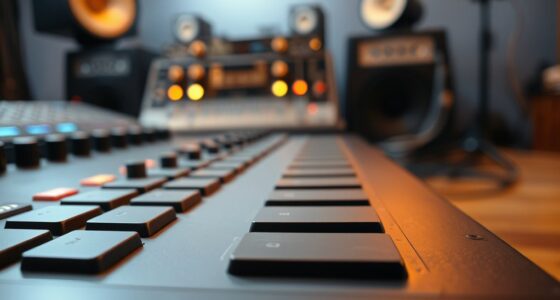To master Mid-Side EQ moves, start by adjusting the mid channel to clarify vocals and bass, and shape the side to widen the stereo image. Use narrow cuts to reduce problematic frequencies and gentle boosts to add air or space. Be cautious with over-boosting to avoid phase issues. Balancing these tweaks can improve clarity and stereo width—keep experimenting with these techniques, and you’ll discover more ways to enhance your mixes effectively.
Key Takeaways
- Use narrow cuts on mid-channel to reduce masking and improve clarity of central elements like vocals and bass.
- Apply gentle high-shelf boosts on the side channel to enhance stereo width and add air to the mix.
- Employ mid-channel cuts at problematic frequencies to fix phase issues and improve mono compatibility.
- Use broad boosts on the side to subtly widen the stereo image without causing phase problems.
- Regularly switch between mono and stereo to ensure your mid-side EQ adjustments maintain balance and clarity.
Understanding the Basics of Mid-Side Processing

Mid-side processing is a powerful technique that allows you to manipulate the stereo image more precisely. By separating your audio into mid (center) and side (stereo spread) components, you gain control over stereo width and phase correlation. The mid channel contains all sounds that are panned centrally, while the side channel captures the differences between left and right signals. Adjusting these channels lets you widen or narrow the stereo image without affecting overall volume or phase issues. This technique is especially useful for correcting phase correlation problems that can cause mono compatibility issues. Understanding how to balance the mid and side signals enables you to create a more immersive, balanced mix. Mastering mid-side processing gives you a versatile tool for shaping your stereo field with clarity and precision.
Key Mid-Side EQ Techniques to Enhance Clarity and Space

To enhance clarity and create a sense of space in your mix, applying targeted EQ adjustments to the mid and side channels is essential. Adjusting the mid channel helps clarify the core elements, like vocals and bass, while shaping the side channel broadens stereo width without muddying the mix. Use high-shelf EQ on the sides to gently boost high frequencies, adding air and openness. Be cautious of phase coherence; overly aggressive EQ changes can cause phase issues that reduce stereo image integrity. Narrow cuts in the mid can reduce masking and clarify elements, while gentle boosts on the sides enhance spatial perception. Incorporating exfoliation benefits can help improve overall clarity and skin health, similar to how precise EQ adjustments improve a mix’s transparency. These key techniques allow you to balance clarity and width, ensuring your mix sounds both spacious and coherent.
Practical Applications and Tips for Effective Mid-Side EQing

Practicing precise adjustments is key to mastering effective Mid-Side EQing. To improve stereo imaging, use Mid-Side EQ to subtly enhance or reduce specific frequencies in either the mid or side channels. This online tool can help you identify passive voice in your writing, ensuring clarity and strength in your communication. This helps you control how elements sit within the stereo field, ensuring a balanced and immersive sound. When balancing frequencies, avoid over-boosting; instead, make gentle cuts or boosts to prevent phase issues and maintain clarity. Focus on narrow cuts to tame problematic resonances and broader boosts for shaping the overall tone. Always listen in mono and stereo to gauge how your adjustments affect the image. Remember, subtlety is your friend—small changes can make a significant difference in achieving a naturally balanced stereo image and cohesive frequency profile.
Frequently Asked Questions
Can Mid-Side EQ Be Used on Stereo Recordings Only?
You might think mid-side EQ is only for stereo recordings, but it’s more versatile. It lets you manipulate psychoacoustic effects and control stereo width across various sources, not just stereo tracks. You can use it on mono recordings to shape the sound’s spatial qualities or enhance stereo images. Mid-side EQ helps you refine your mix’s depth and clarity, making it a powerful tool no matter the recording’s original format.
How Does Mid-Side EQ Affect Mono Compatibility?
Ah, the classic quest for mono compatibility—because everyone loves a surprise when their stereo mix collapses! Using mid-side EQ affects mono compatibility by tweaking phase correlation, which influences how well the stereo image collapses to mono. If you overdo it, you risk phase issues that cause parts of your mix to disappear or sound hollow. So, be cautious; balance is key to maintaining both a rich stereo image and mono friendliness.
What Are Common Mistakes to Avoid With Mid-Side EQ?
When using mid-side EQ, you should avoid common mistakes like over-processing, which can cause phase issues and phase cancellation. Don’t boost or cut frequencies excessively on either the mid or side channels, as this can lead to unnatural sounds or phase conflicts. Always listen carefully in mono and stereo to make certain your adjustments don’t introduce phase problems. Regularly check your mix on different systems to prevent phase issues from affecting your final sound.
Is Mid-Side EQ Suitable for All Music Genres?
Think of mid-side EQ like a versatile artist’s toolkit. It’s highly effective for controlling stereo imaging and enhancing specific elements, but it’s not suitable for every genre. For example, it works great for pop or electronic music where you want precise stereo control. However, in genres like mono-focused jazz or acoustic, mid-side EQ might be unnecessary or even disruptive. So, consider your genre’s needs before applying this powerful technique.
How Do I Identify When to Use Mid or Side Adjustments?
You identify when to use mid or side adjustments by listening for issues with stereo imaging or phase correlation. If elements are too centered or lack width, boost or cut in the side channel to enhance space. Conversely, if certain sounds are out of phase or too wide, focus on the mid channel. Trust your ears, and use mid-side EQ to balance the stereo image and improve phase coherence.
Conclusion
Think of mid-side EQ as the painter’s brush, shaping the scene’s depth and focus. By mastering these techniques, you wield the tools to carve out space and clarity in your mix, like revealing a hidden landscape behind a foggy veil. With each adjustment, you’re sculpting a sonic horizon—brightening the foreground and subtly receding the background. Embrace this craft, and your mixes will resonate with newfound clarity, inviting listeners into a vivid, immersive soundscape.










